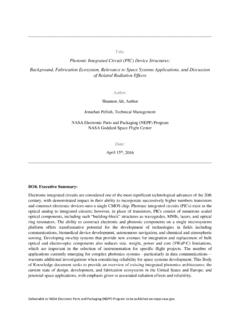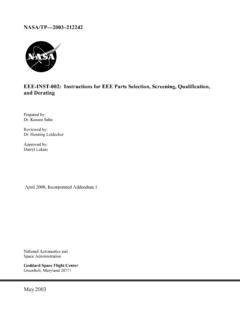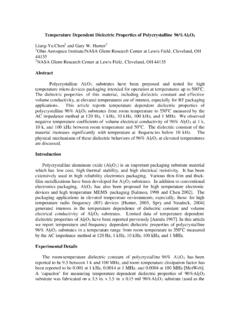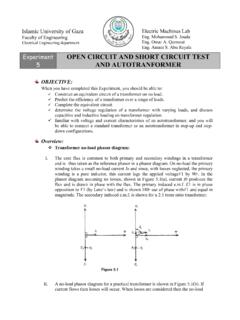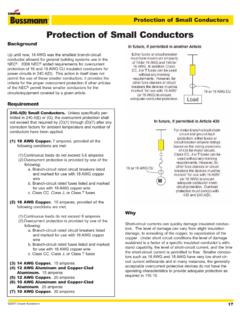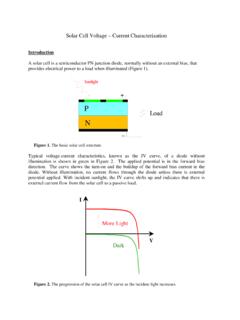Transcription of IEEE TRANSACTIONS ON ELECTRONICS PACKAGING …
1 IEEE TRANSACTIONS ON ELECTRONICS PACKAGING MANUFACTURING, VOL. 32, NO. 1, JANUARY 200941 Tin whisker electrical short CircuitCharacteristics part IIKarim J. Courey, Shihab S. Asfour, Arzu Onar, Jon A. Bayliss, Lawrence L. Ludwig, and Maria C. WrightAbstract Existing risk simulations make the assumption thatwhen a free tin whisker has bridged two adjacent exposed electricalconductors, the result is an electrical short circuit . This conserva-tive assumption is made because shorting is a random event thathas an unknown probability associated with it. Note however thatdue to contact resistance, electrical shorts may not occur at lowervoltage levels. In our first paper, we developed an empirical prob-ability model for tin whisker shorting. In this paper, we develop amore comprehensive empirical model using a refined experimentwith a larger sample size, in which we studied the effect of varyingvoltage on the breakdown of the contact resistance which leads to ashort circuit .
2 From the resulting data, we estimated the probabilitydistribution of an electrical short , as a function of voltage. In addi-tion, the unexpected polycrystalline structure seen in the focusedion beam (FIB) cross section in the first experiment was confirmedin this experiment using transmission electron microscopy (TEM).The FIB was also used to cross section two card guides to facilitatethe measurement of the grain size of each card guide s tin platingto determine its Terms Contact resistance, focused ion beam (FIB), shortcircuit, tin whiskers, transmission electron microscopy (TEM).I. INTRODUCTIONTIN WHISKERS are crystalline filamentary surface erup-tions from a tin-plated surface that can have a varietyof shapes including straight, kinked, and curved [1]. The haz-ards presented by tin whiskers include temporary and perma-nent electrical short circuits, debris contamination, and metalvapor arcing [2].
3 Failures attributed to metal whiskers have beendocumented in many industries including the nuclear power,Manuscript received July 31, 2008; revised October 28, 2008. Current versionpublished January 08, 2009. This document was prepared under the sponsorshipof the National Aeronautics and Space Administration. Neither the United Statesgovernment nor any person acting on behalf of the United States governmentassumes any liability resulting from the use of the information contained in thisdocument, or warrants that such use will be free from privately owned work was supported in part by S. Stich, S. M. Poulos, A. Oliu, J. N. Cowart,and S. J. McDanels of the National Aeronautics and Space Administration. Thiswork was recommended for publication by Associate Editor R. Gedney uponevaluation of the reviewers J.
4 Courey is with the Orbiter Sustaining Engineering Office, NationalAeronautics and Space Administration, Kennedy Space Center, FL 32899 USA(e-mail: S. Asfour is with the College of Engineering, University of Miami, CoralGables, FL 33146 USA (e-mail: Onar is with the Biostatistics Department, St. Jude Children s ResearchHospital, Memphis, TN 38105 USA (e-mail: A. Bayliss, L. L. Ludwig, and M. C. Wright are with the Mate-rials Science Division, National Aeronautics and Space Administration,Kennedy Space Center, FL 32899 USA (e-mail: versions of one or more of the figures in this paper are available onlineat Object Identifier , satellite, missile, military aircraft, and medical in-dustries [3]. An extensive list of metal whisker failures and ex-tensive documentation of the tin whisker phenomena can befound on the National Aeronautics and Space Administration(NASA) Goddard Space Flight Center tin whisker home page( ).))))
5 Tin whiskers can pose serious problems in high-reliabilitysystems that can result in loss of life as well as significant capitallosses. Improving our ability to assess the risk associated withtin whiskers is an important area of study for both the govern-ment and private industry [4].Risk simulations have been developed by the Center for Ad-vanced Life Cycle Engineering (CALCE) at the University ofMaryland, and TYCO ELECTRONICS [5], [6] . In these simulations,it is assumed that physical contact between a whisker and anexposed contact results in an electrical short . This conservativeassumption was made because the probability of an electricalshort from tin whiskers had not yet been determined at the timethe simulations were written [4]. Fang [5] noted the differencebetween experiment and simulated results and attributed the dif-ference to contact voltage level at the transition to metallic conduction cur-rent is the voltage level at which the contact resistance breaksdown.
6 Experiments were designed to develop an empiricalmodel to quantify the probability of occurrence of an electricalshort circuit from tin whiskers as a function of voltage. In ourfirst paper, we developed an empirical probability model for tinwhisker shorting [4].The second experiment which is detailed in this paper incor-porated the lessons learned from the first experiment. It deter-mined the breakdown voltage for a larger sample (versus) of whiskers with the objective of obtaining amore comprehensive empirical distribution. The observed datawas used to determine the best fitting parametric distribution tothe breakdown voltage. The associated data analysis also incor-porated explorations of possible sources of variability. In addi-tion, transmission electron microscopy (TEM) was used to studyand determine if the whisker that was sectioned in the first ex-periment was polycrystalline or a single crystal.
7 Also, an FIBwas used to section a sample of one card guide from each as-cent thrust vector controller (ATVC) to determine if the platingthat grew the whiskers was bright or matte BACKGROUNDIn our first experiment, we found the best fitting distribu-tion was the three parameter (3P)-inverse Gaussian (IG) dis-tribution [4]. The parameters for the 3P-IG Distribution were1521-334X/$ 2008 IEEEA uthorized licensed use limited to: University of Maryland College Park. Downloaded on January 12, 2009 at 16:34 from IEEE Xplore. Restrictions TRANSACTIONS ON ELECTRONICS PACKAGING MANUFACTURING, VOL. 32, NO. 1, JANUARY 2009 Fig. 1. FIB image of as-sectioned tin whisker shows apparent variation in grainorientation within the cross section. The image was taken at a 52angle fromhorizontal [NASA/University of Central Florida (UCF)].
8 Reproduced from [4].,,. The probability den-sity function (pdf) for the 3P-IG distribution is shown as follows[7]:( )Based on our data, the expected voltage (mean) where a shortwill occur for the 3P-IG distribution isVdc,with a variance of[8]. Tin whiskers fromthe same card guide used in the breakdown voltage experimentwere cross sectioned using an FEI 200 TEM FIB with a 30-kVGallium liquid metal ion source. The ion beam was used to millaway whisker material until the desired region of interest wasexposed to obtain a cross section normal to the whisker s growthdirection [4].The FIB cross section facilitated the examination of what ap-peared to be grains with varying crystallographic orientationswithin the tin whisker as illustrated in Fig. 1. An additional twowhiskers from the card guide were removed and sectioned bythe FIB.
9 These smaller diameter whiskers exhibited the com-monly reported single crystal EXPERIMENTALPROCEDURESA. Tin whisker Breakdown Voltage ExperimentTo determine the break down voltage, a micromanipulatorprobe was brought in contact with the side of a tin whiskergrowing from a tin-plated beryllium copper card guides as il-lustrated in Fig. cantilever beam whisker model shown in Fig. 3 from ourfirst paper illustrates the mechanical load placed on the whiskerby the micromanipulator probe [4].In this model,the force applied to the whisker ,the distance from the base of the whisker to the applied force,Fig. 2. Micromanipulator probe in contact with a tin 3. Cantilever beam whisker model. Reproduced from [4].the whisker deflection,the moment of inertia, andthe modulus of elasticity [4].
10 ( )From ( ), the distance from the base of the whisker to theapplied force has a much greater effect on the force applied tothe whisker than the whisker deflection. Since our objective wasto minimize the force applied to the whisker , the micromanip-ulator probe was applied to approximately the top 25% of thelength of the whisker . In addition, as soon as contact was madebetween the micromanipulator probe and the whisker , as seenunder a microscope, the probe was not moved any further. Thisminimized whisker deflection. The combination of these twocontrols minimizes the force applied to the acquisition software was written using LabVIEW to au-tomate both the incrementing of power supply voltage changesas well as the gathering of the voltage and current data for eachof the tin whiskers.

